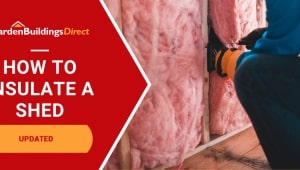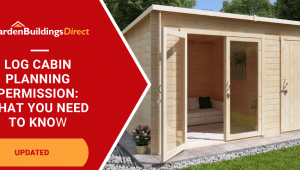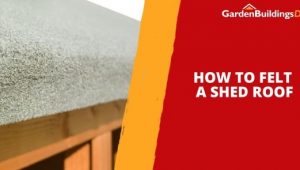Jump to:
More people are setting up home gyms these days. It’s cheaper, more convenient, and lets you work out in peace. For those with limited space inside the house, taking advantage of the garden is the next best step in the fitness journey. Whether it’s working out under the open sky, or setting up a garden gym room, here are the best ideas for outdoor gym setups.
Add a gym shed
Outdoor workouts aren’t possible in all weathers, and that’s where a gym shed comes in. With many shed owners already using them to store exercise equipment, it can be a relatively simple task to turn that space into a full-fledged workout zone.
But, isn’t that just the same as working out in the house?
No! For starters, you can combine both indoor and outdoor exercises in the same workouts. Plus, when you leave the doors open, you get the full benefit of fresh air even while it’s raining.
If you’re serious about exploring this option, our garden gyms guide can help you figure out what type of building is right for you.
Basic Outdoor Gym Equipment You Might Need
We would recommend that you don’t store metal gym equipment outside unless it’s bolted down. Metal items are, unfortunately, a thief magnet. That includes cast iron weights, as great as they are. If you’re going to use them outside, lock them up securely afterwards. So, if you’re not going for a full gym shed, at least make sure you’ve got some secure outdoor storage to put the stuff away.
First of all, consider rubber mats or foam tiles, which can help immensely when working out on uneven or hard ground. This helps reduce tension from high-impact moves like jumping, as well as making things easier on your knees and wrists when it comes to on-the-floor moves.
You’ll also want to make a list of only the equipment you’ll only use, so you don’t end up cramming everything in. If you’re just getting started, here are the basics (which also work for small spaces):
For strength training
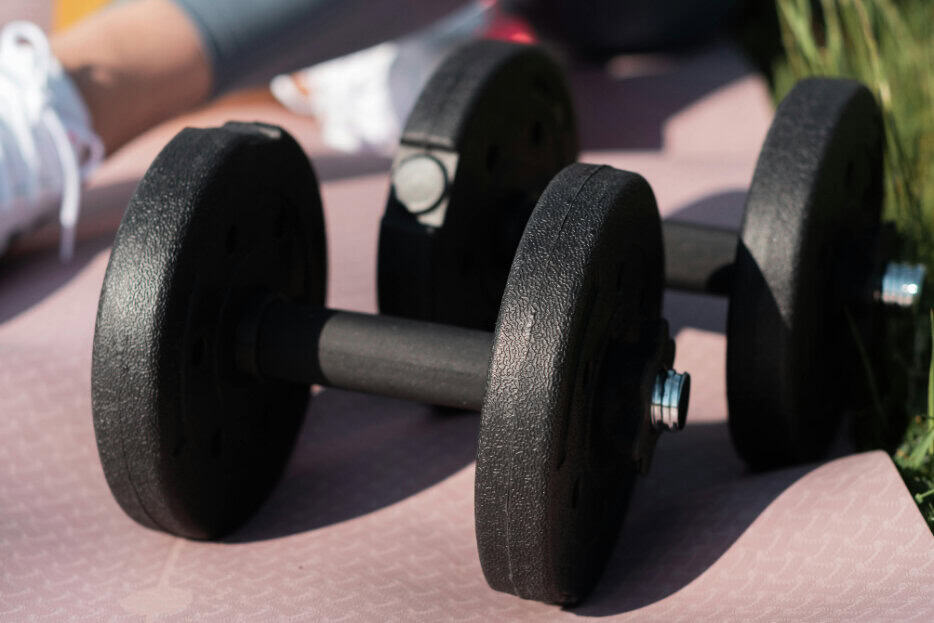
Are you looking to build strength? Dumbbells, kettlebells, and resistance bands are pretty much essentials.
Dumbbells are great because you can use them for loads of different exercises to focus on muscles and endurance. Kettlebells are fantastic for adding functional strength, as they simulate lifting a heavy bucket or suitcase. Resistance bands are brilliant for warmup moves, lower-strain forms of lifting, and for training the end-range of a movement.
You can keep your dumbbells, kettlebells, or resistance bands in a storage box. Take them out only when you need them and store them away again afterwards to avoid clutter.
For cardio training
There are loads of cardio workouts that don’t require any equipment whatsoever. Simply look up some bodyweight workouts on YouTube and follow along in your garden. Dumbbells and kettlebells can also be used in a cardiovascular fashion that focuses on boosting your heart rate for a period of time. However, what most people think of when they hear ‘cardio’ is something along the lines of running.
For running, you might consider using your local neighbourhood, as long as you feel safe and the terrain is suitable. Or, if your garden is large enough, simply set out a circuit to follow and get going. Just try not to wear out the lawn. Failing that, a treadmill is your only real at-home alternative. And for that, you’ll definitely need a building, with electricity installed.
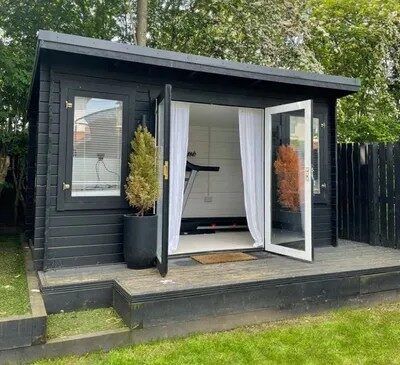
The great thing about a treadmill in a garden room is that you not only get the convenience of running in a sheltered, private, convenient space, but you get to look at the garden and have fresh air while you’re doing it.
Fitness Equipment for your Gym Shed
So, you’re investing in a garden gym room. Nicely done. Now here are the best ideas for equipment to fill it with.
Multi-gym machines
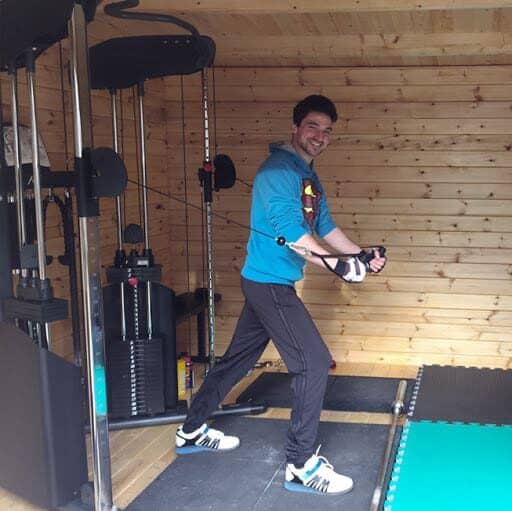
They can cost between £300 and £1,000, but multi-purpose gym machines are perfect for targeting just about every muscle on the body, making them the ideal instrument to add to your garden gym setup.
Cable machines, in particular, are brilliant because you can push and pull the handles in any direction, seated or standing. And they’re not just for the upper body, either. You can change the handles for ankle straps to perform certain leg exercises, or stick a bar across both cables for really heavy moves. They often come with a pull-up bar at the top.
A bench
This one is a must-have if you want to change things up in your strengths routine. It’s great for bench presses, step-ups, and even seated exercises. Having a bench also gives you a lot more options for a fully-body workout, and it’s pretty versatile!
Mount a pull-up bar on the wall
If you’re not going for a machine which has pull-up handles at the top, a pull-up bar is a great idea. These are fantastic for calisthenics training, helping to build strength in your back and arms while also improving climbing skills. When installing a pull-up bar in a wooden gym shed, it’s essential to check the wall strength—particularly if you’re using a shed with thinner walls. For a more stable setup, consider using a log cabin with at least 28mm thick walls for better durability and support.
Alternatively, install one on the side of your house for an outdoor solution. Just remember that birds might perch on it, and you might have to dry it before use.
Fight Training Workout Setup
Whether it’s for boxing or MMA, if you’re looking to add a fight training component to your garden gym, a punch bag is a must-have. Hanging it from the ceiling provides the space it needs to swing freely, making your workout more effective.
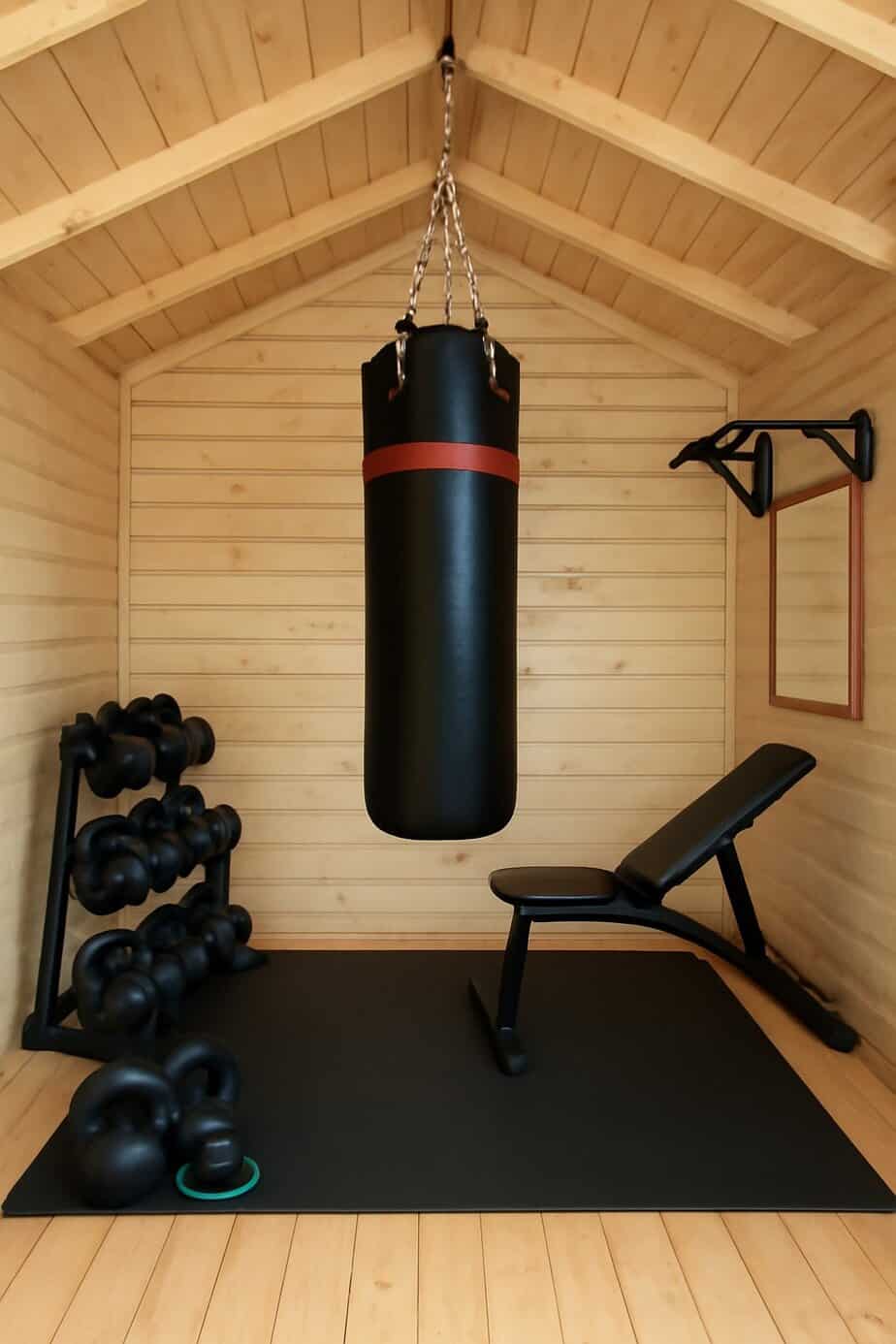
The ideal setup would involve installing the punch bag at the centre of the gym where it can move freely, but if space is limited, you can mount it at one end of the room (so long as you’re happy for it to bounce off the walls). Ensure that the bag is securely attached to roof trusses, not just a wooden board, to support the weight of the bag and ensure safety during use. If your garden gym has an apex roof, this can offer more room for the bag to swing, adding more versatility to your workout.
Best Outdoor Gym Exercises
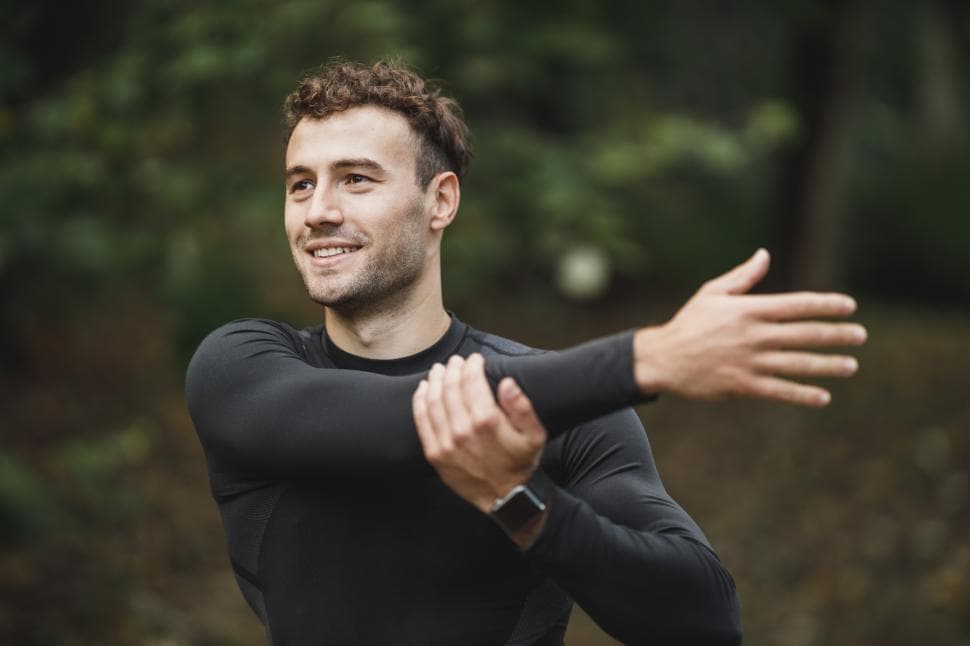
(Image Credit: Freerange Stock)
Always start and finish your workout routine with a good warm-up and some stretching. Here are some good dynamic stretches to try:
- Leg swings: Stand next to something for support and swing one leg forward and back. Do 10-15 swings on each leg.
- Arm circles: Stretch your arms out to the sides and start making small circles. Gradually make the circles bigger. Do 2 sets of 10 in each direction.
- High knees: Jog on the spot and bring your knees up as high as you can. Keep it going for 30 seconds to a minute.
- Torso twists: Stand with your feet shoulder-width apart. Then, twist your torso from side to side while keeping your hips still. Do 2 sets of 15 twists each side.
- Ankle rolls: Lift one foot and rotate your ankle clockwise, then counterclockwise. Do 10 rolls in each direction, then switch to the other foot.
These strength exercises hit different muscle groups:
- Bodyweight squats: Stand with your feet shoulder-width apart. Squat down like you’re sitting back into a chair, then stand up again. Aim for 3 sets of 15.
- Push-ups: Get into a plank position, lower yourself by bending your elbows, then push back up. Start with 3 sets of 10.
- Dumbbell rows: Bend at the hips, hold the dumbbells, and pull them towards your hips. Do 3 sets of 12 reps per arm.
- Lunges: Work your legs by stepping forward with one foot. Low your hips until both knees are bent at 90 degrees. Aim for 3 sets of 12 reps per leg.
- Plank: Hold the plank position for 30-60 seconds, keeping your body straight from head to heels.
Cardio exercises that are good for your heart, improve endurance, and burn calories:
- Jogging: Start with a decent pace and keep a steady rhythm. Focus on good posture and breathing. Start with 10 minutes and build it up over time.
- Jumping rope: Make sure the rope’s the right length, then stand with your feet shoulder-width apart. Swing the rope over your head and jump with each turn. Aim for 10 minutes, gradually picking up the pace.
- HIIT: Do short bursts of intense exercises like jumping jacks or sprints, then take breaks. You could do 30 seconds of hard work, followed by 30 seconds of rest. Adjust it as you go.
- Burpees: A combination of push-ups and squats (or even jump squats), counting how many burpees you can do is a way to test how fit you really are.
Read our guide to ‘The Best Exercises for Your Garden Gym’ for more!
Shop Garden Gym Rooms